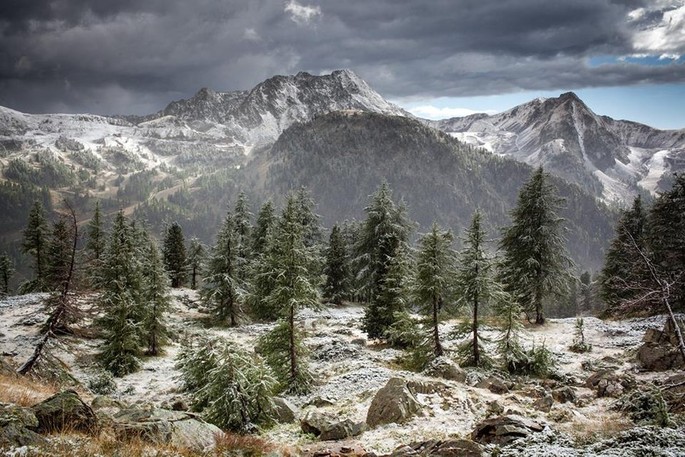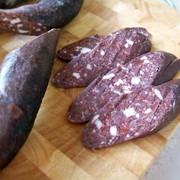They are all accessible by a large network of roads and hiking trails. From the sea to the mountains, you will discover an incredible diversity marked by a strong historical past and a unique biogeographic position between Mediterranean and Alpine influences offering exceptional landscapes and biodiversity. From one valley to another, each place is unique and makes you travel through time. You will be captivated by the scenery that offers the succession of lakes, hills, mountains, gorges ... Let us guide you and take the time to explore each site on your own.
VALLEY ROYA-BEVERA
The Authion
This Massif is a place charged with history: With the Forts de la Forca, des Milles Fourches, Redoute des Trois Communes, Camp de Cabanes Vieilles ... are all remnants of the military past of this strategic site. natural fortress rising to over 2000 m high, with a breathtaking view of the Mediterranean to the Alps, the Authion faces the Col di Tenda, which was the prerequisite of "Salt Road" between Nice and Piedmont .
Valley of Wonders and Fontanalbe
A monument in the National Park: 36,000 engravings from the Copper Age and Early Bronze Age (from 3200-1700 BC), they are an exceptional archaeological heritage. Hornformed, weapons and tools, geometrical figures, as many engravings of scenes of pastoral life. At the foot of the sacred mountain of Bego, refer to anthropomorphic human figures but also to the gods as "the witch". More information about the Valley of Wonders, see our former article:
The Tende Pass
The connection point between the crystalline Argentera massif and limestone and karst Marguareis massif , marks the transition between two "worlds": the terraces of the Mediterranean Valley Roya give way to more severe and typical alpine scenery of the valleys that descend to Cuneo. Men, mules and carts ridged the road that crossed the pass during several centuries until the construction of the tunnel, which began in 1782. Many forts of the nineteenth century of the House of Savoy and the military road, which runs along the line of watershed, bear witness of the strategic importance of this site.
VESUBIE VALLEY
The high valley of Gordolasque
It is primarily due to gigantic glaciers that occupied this valley 20,000 years ago and have modulated this impressive landscape, where the mineral element is omniprésent.At the bend of a trail, visitors can see a chamois and photograph a little shy ibex. Among the many flowers, cinquefoil valdieri endemic in the Argentera-Mercantour massif.
Madonna of Fenestre
The legend says that it is an apparition of the Virgin in a halo of light, nearby Gélas summit, the "Window Cayre," which decided the Templars to build the Shrine of Our Lady of -Fenestre, where they lodged a cedar statue brought from Palestine. Each year, even today, 15 August and 8 September are pilgrimage dates to Our Lady.
The high valley of Boréon
Covered with a dark forest of fir and spruce that encircles an artificial lake, it is a protected site since over 50 years where wildlife is observed easily. This green area is the starting point for many hikes particular to the lake Negro and Lake Trécolpas. We also joined the refuge of Cougourde at the foot of the top of Cougourde and its famous west face, high 400 meters very traveled by climbers of all levels.
TINÉE VALLEY
Fort Rimplas and fortified structure of Frassinéa
From Rimplas fort built on a rocky outcrop, the view embraces the landscape of the Tinée Valley. This military building was first built on the Maginot Line, started in 1928, it was completed in 1937. It housed a garrison of 350 men. The Frassinéa, one of the annexes was built between 1935 and 1939. All of its fortifications designed to stop the intrusion of Italian tanks were hardly exploited. Today, tours are offered for Frassinéa, fortification that was rehabilitated.
Vens Lakes
These beautiful glacial lakes range from 2286-2327 meters above sea level in the rocky hemmed greenery. Their still, clear waters reflect the surrounding peaks and feed below a series of breathtaking waterfalls. These high valleys are home to early summer exuberant flora. Saxifrage multiple flowers, endemic in Argentera Mercantour, clings obstinately in crevices of the high slopes to flourish there once and die.
HAUT-VAR/CIANS VALLEY
Daluis Defile
The cliff road Gorges Daluis takes you to the heights of Mercantour. Its vertiginous walls were carved in red mudstones by the torrent of Var known for its violent floods. Nicknamed the "Nice Colorado", this site is exceptional for its landscapes, its rich fauna and flora.
Péone village
This Alpine village stands proudly along the wall. The visitor is struck by the impressive aspect of its architecture, accentuated by the presence of the "Demoiselles" above it. Two queens were born here: Marie-Julie Clary (1771-1845), married to Joseph Bonaparte, king of Naples and Spain and Désirée Clary (1777-1860) who married Bernadotte, King of Sweden in 1818.
Cayolle Pass
This pass is located on historic thoroughfare between the high valleys of the Var and Ubaye, revived today as "Route des Grandes Alpes". It is an ideal starting place for hiking, a popular pass known to all cyclists. It is accessed from the Estenc hamlet, where the Var river rises. Hay meadows, larch forests and pastures follow each other to the top of this protected high landscape value. Its original natural beauty has been restored through rehabilitation efforts of the National Park .
HAUT-VERDON VALLEY
Colmars
Colmars-les-Alpes has the label "Village and City of Character". This former border town is protected by a fortified enclosure by Vauban. Porte de France and the Porte de Savoie open onto a city with narrow streets that slowly reveal the charm of old houses and squares with fountains. The landscape of forested mountains are lush backdrop for this superb authentic village.
Ratery Forest
A remarkable forest where once the slope was only rubble. At the end of the 19th century, the state launches large-scale reforestation activities, 600,000 conifers are planted. Today larch, pine enjoying the sunny mountain areas in the rich wood and prized by cattle alongside, among others, the Swiss stone pine. It nourishes the nutcracker, noisy and providing bird, which constitutes seed supplies.
Allos Lake
The lake carved by glaciers, is dominated by five magnificent sandstone towers of Annot. From its 3050 meters Mount Pelat watches over this magical and harmonious landscape, frequented by many species of animals such as goats, chamois, marmots, golden eagles. The largest natural lake in Europe at more than 2,200 meters above sea level, is surrounded by lawns dotted with larches.
UBAYE VALLEY
Bonnette Pass
A grand panorama at the contact point between the Alpes-Maritimes and Alpes de Haute Provence. An orientation board helps to identify the surrounding peaks, from Mount Mounier to the border range 3,000 meters abound. The view extends to the north of Mount Viso in Italy to the 4,000 meters of the Ecrins National Park. The remains of fortifications, reflecting the military history of this strategic site, are visible here and there like Fort Pelousette and fort of Forks.
Bachelard
Between the defiles of the Corbiere and the sumptuous climb of the Cayolle Pass, runs the wild valley of Bachelard. Punctuated by dry stone walls and early works of the twentieth century, the Route des Grandes Alpes through hamlets with traditional architecture, flowery meadows, misty larch, before emerging in the heart of the National Park Mercantour on the Col de Cayolle.
Read also our first article























